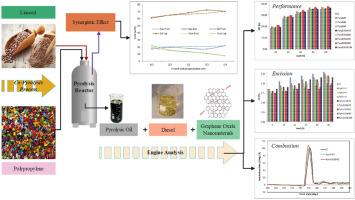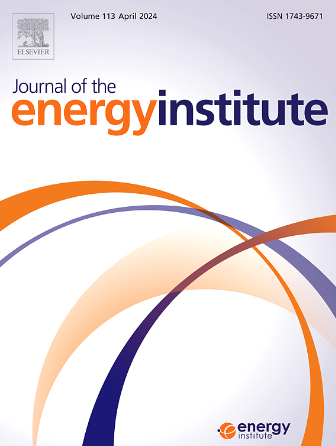通过非食用亚麻籽和废聚丙烯的共热解协同回收可再生碳氢化合物资源:塑料对石油生产的影响及其用作集成电路发动机燃料的研究
IF 5.6
2区 工程技术
Q2 ENERGY & FUELS
引用次数: 0
摘要
这项研究探讨了亚麻籽和聚丙烯的联合热解,以生产热解油,作为集成电路发动机的化石燃料替代品。研究结果表明,与单独热解亚麻籽和聚丙烯相比,联合热解对产油量具有积极的协同效益。首先,研究调查了在 350 °C 至 650 °C 的温度下,亚麻籽在不同混合比例下进行共热解时对聚丙烯的影响。亚麻籽和聚丙烯热解获得的最大油产率分别为 61.1 wt% 和 73.6 wt%,而当混合比为 2:3 时,油产率的最大正协同效应为 6.2%。傅立叶变换红外光谱法(FT-IR)、气相色谱质谱法(GC-MS)和物理特性被用来进一步评估在最大协同作用下产生的热解油。结果发现,这种油的热值较高,为 43.09 兆焦/千克,与化石柴油相当接近。为进行发动机分析,制备了八种不同的含热解油和氧化石墨烯(GO)纳米颗粒的混合物,分别命名为 PyroD20(20 % 共热解油 + 80 % 柴油)、PyroD40、PyroD50、PyroD20@20(PyroD20 + 20 ppm GO)、PyroD20@40、PyroD20@60、PyroD20@80 和 PyroD20@100。随后,对混合燃料进行了发动机测试,以将它们与基准柴油(D)进行比较。在最大负荷下,PyroD20 和 PyroD20@60 的制动热效率(BTE)分别为 37.2 % 和 37.8 %,比 D 高 6.0 % 和 7.8 %。使用 PyroD20@60 后,一氧化碳 (CO)、碳氢化合物 (HC) 和烟的排放量分别减少了 27.0%、7.3% 和 21.2%。生产出的可再生液态油可以与传统柴油混合使用,用于集成电路发动机的运行。本文章由计算机程序翻译,如有差异,请以英文原文为准。

Synergistic recovery of renewable hydrocarbon resources via co-pyrolysis of non-edible linseed and waste polypropylene: A study on influence of plastic on oil production and their utilization as a fuel for IC engine
This study looked into the co-pyrolysis of linseed and polypropylene to produce pyrolysis oil as a fossil fuel substitute for IC engines. The outcomes showed positive synergistic benefits on oil yield from co-pyrolysis as compared to the pyrolysis of individual components. Initially, the study investigated the effect on polypropylene during co-pyrolysis with linseed at temperatures between 350 °C and 650 °C under different blend ratios. The maximum oil yields for the pyrolysis of linseed and polypropylene obtained were 61.1 wt% and 73.6 wt%, respectively, whereas the maximum positive synergy on oil yield was 6.2 % at 2:3 blend ratio. Fourier transform infrared spectroscopy (FT-IR), gas chromatography mass spectrometry (GC-MS), and physical characteristics were used to further evaluate the pyrolysis oil produced at maximum synergy. It was found that the oil had a higher calorific value of 43.09 MJ/kg, which was fairly close to fossil diesel. For engine analysis, eight different blends containing pyrolysis oil and graphene oxide (GO) nanoparticles were prepared and named PyroD20 (20 % co-pyrolysis oil + 80 % diesel), PyroD40, PyroD50, PyroD20@20 (PyroD20 + 20 ppm GO), PyroD20@40, PyroD20@60, PyroD20@80, and PyroD20@100. After that, an engine test was conducted on the blended fuels to compare them to the baseline diesel fuel (D). At maximum load, the brake thermal efficiency (BTE) for PyroD20 and PyroD20@60 was found to be 37.2 % and 37.8 %, respectively, which was 6.0 % and 7.8 % higher than those of D. The brake-specific fuel consumption (BSFC) for PyroD20 and PyroD20@60 was reduced by up to 22.0 % and 22.7 %, respectively, compared to D. With the use of PyroD20@60, the emissions of carbon monoxide (CO), hydrocarbon (HC), and smoke were reduced by up to 27.0 %, 7.3 %, and 21.2 %, respectively. The produced renewable liquid oil may certainly be used in blends with conventional diesel for IC engine operation.
求助全文
通过发布文献求助,成功后即可免费获取论文全文。
去求助
来源期刊

Journal of The Energy Institute
工程技术-能源与燃料
CiteScore
10.60
自引率
5.30%
发文量
166
审稿时长
16 days
期刊介绍:
The Journal of the Energy Institute provides peer reviewed coverage of original high quality research on energy, engineering and technology.The coverage is broad and the main areas of interest include:
Combustion engineering and associated technologies; process heating; power generation; engines and propulsion; emissions and environmental pollution control; clean coal technologies; carbon abatement technologies
Emissions and environmental pollution control; safety and hazards;
Clean coal technologies; carbon abatement technologies, including carbon capture and storage, CCS;
Petroleum engineering and fuel quality, including storage and transport
Alternative energy sources; biomass utilisation and biomass conversion technologies; energy from waste, incineration and recycling
Energy conversion, energy recovery and energy efficiency; space heating, fuel cells, heat pumps and cooling systems
Energy storage
The journal''s coverage reflects changes in energy technology that result from the transition to more efficient energy production and end use together with reduced carbon emission.
 求助内容:
求助内容: 应助结果提醒方式:
应助结果提醒方式:


